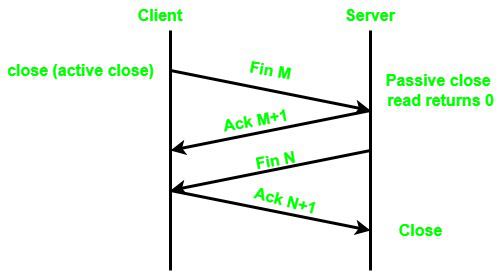TCP protocol is one of the network protocols we use in our daily lives. It is responsible for establishing and terminating connections. In the previous blog post, we analyzed why TCP requires three handshakes to establish a connection. When establishing a connection, we need to ensure the issues of historical connections and sequence numbers. Unlike the three-way handshake during connection establishment, disconnecting a TCP connection requires a four-way handshake. This article will explore why TCP disconnects require a four-way handshake instead of three or any other number.
This article is first published in the medium MPP plan. If you are a medium user, please follow me in medium. Thank you very much.

Overview
Before delving into why a four-way handshake is necessary, let’s first understand the process of TCP connection termination. Typically, when one party in the communication decides to terminate the connection, it sends a FIN (Finish) control message to the other party, indicating that it has no more data to send. The receiving party responds with an ACK (Acknowledgment) control message to acknowledge and enters a half-closed state, indicating that it will no longer send data but can still receive data. When the other party also has no more data to send, it sends a FIN message to indicate its intention to disconnect. The receiving party then sends another ACK message to confirm, and only then will the connection be fully closed.

Design
Why does TCP disconnect require a four-way handshake? Let’s analyze this question from several aspects:
Ensuring Data Integrity
TCP is a connection-oriented reliable transport protocol that guarantees data reliability and integrity. During connection termination, both parties may still have unsent or unacknowledged data packets. If only a three-way handshake is performed, the other party may not know whether the FIN message it sent has been received during the final handshake. This could result in the other party not fully receiving the data, leading to data loss. Therefore, by performing a four-way handshake, both parties can ensure that they receive each other’s data completely and maintain data integrity.
Handling Network Latency and Packet Loss
In a network, data packets may be delayed or lost due to network latency or packet loss. During connection termination, if only a three-way handshake is performed, the other party may not know whether the FIN message it sent has been received, which may prevent timely closure of the connection. By performing a four-way handshake, sufficient time is provided for the network to handle latency and packet loss issues, ensuring that the connection can be properly closed.
Waiting for Unsent Data to Be Sent
During connection termination, both parties may still have unsent data packets. If only a three-way handshake is performed, the other party may not know whether there is any unsent data before sending the FIN message. By performing a four-way handshake, both parties have enough time to send and receive the remaining data, ensuring data integrity and correctness.
Handling the Half-Closed State
During the TCP connection termination process, one party enters a half-closed state by sending a FIN message, indicating that it will no longer send data but can still receive data. If only a three-way handshake is performed, the other party will immediately close the connection upon receiving the FIN message, which may prevent proper handling of the half-closed state. By performing a four-way handshake, both parties can ensure the correct handling of the half-closed state, avoiding data loss and confusion.
Conclusion
Based on the analysis above, we can conclude that a four-way handshake is necessary for TCP disconnection to ensure data integrity, handle network latency and packet loss, wait for unsent data to be sent, and handle the half-closed state. Through the four-way handshake, both parties can better coordinate and handle the disconnection, ensuring the correct transmission of data and secure closure of the connection.
When discussing TCP disconnection, we should not focus on why a four-way handshake is used, but rather understand why multiple handshakes are needed to ensure data integrity and proper connection closure. By gaining a deep understanding of TCP protocol design, we can better apply and comprehend the principles and mechanisms of network communication.
Whether it is three handshakes or four handshakes, the first element of a tcp connection to consider is always security and data integrity, although it seems that three handshakes and four handshakes seem to be very inefficient, but the vast majority of Internet traffic is based on the tcp protocol, which is enough to prove that its reliability, on the issue of performance, there are other ways to optimize the performance of the protocol, such as udp, and later on, we will analyze how UDP and UDP-based QUIC protocol will affect the Internet in the next ten years. and how the UDP-based QUIC protocol will influence the next decade of the Internet.
If you found my article enjoyable, feel free to follow me and give it a 👏. Your support would be greatly appreciated.